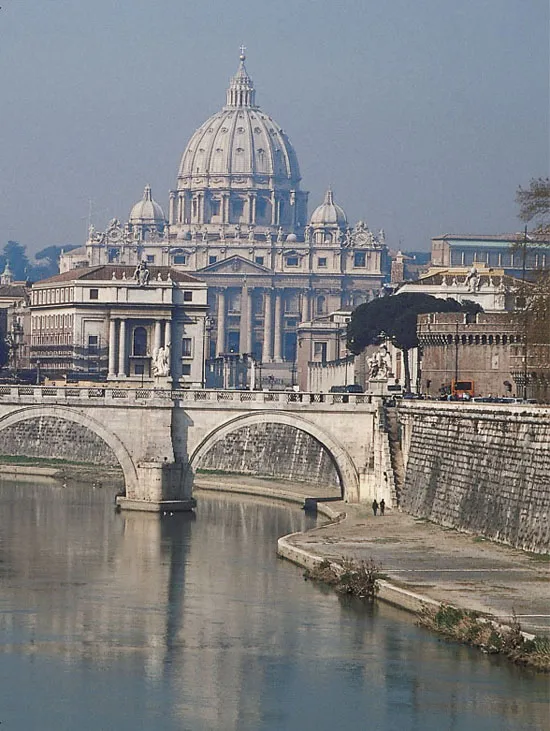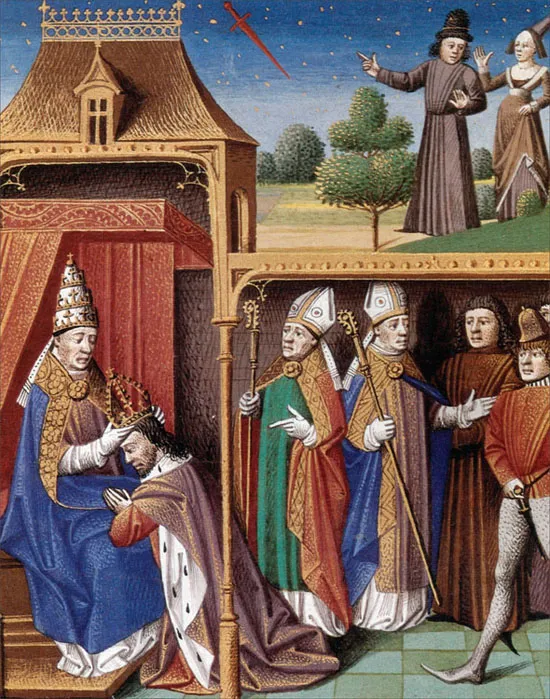![]()
St Peter’s Basilica in Vatican City (pictured) was by tradition the burial site of St Peter, the first Bishop of Rome and first in the line of papal succession. Here its dome rises above the facade begun in 1605 by the architect Carlo Maderna.
I
THE CADAVER SYNOD, THE RULE OF THE HARLOTS, AND OTHER VATICAN SCANDALS
One thousand years ago and more, political instability was rife in Rome. At that time, the image of the papacy was everything from outlandish to weird to downright appalling. All kinds of dark deeds stuck to its name. Corruption, simony, nepotism and lavish lifestyles were only part of it, and not necessarily the worst.
Benedict IX (pictured), one of the most scandalous popes of the 11th century, was described as vile, foul, execrable and a ‘demon from Hell in the disguise of a priest’.
During the so-called ‘Papal Pornocracy’ of the early tenth century, popes were being manipulated, exploited and manoeuvred for nefarious ends by mistresses who used them as pawns in their own power games. With some justification, this era was also called the Rule of the Harlots.
HOW TO FIND A MISSING POPE
So many popes were assassinated, mutilated, poisoned or otherwise done away with that when one of them disappeared, never to be seen again, it was only natural to scan a list of violent explanations to find out what had happened to him. Death by strangulation in prison was a frequent cause. Had the vanished pope been hideously mutilated and therefore made unfit to appear in public? Had he made off with the papal cash box? Or should the brothels and other houses of ill repute be searched to find out if he was there? Often, there was no clear answer and explanations were left to gossip and rumour.
By the ninth century, the papacy and the popes were the playthings of noble families.
One thing was certain, though: by the ninth century, the papacy and the popes were the playthings of noble families like the Spoletans, who controlled cities such as Venice, Milan, Genoa, Pisa, Florence and Siena, among others. Through their wealth and influence, and their connections with armed militias, these families formed what amounted to a feudal aristocracy. They were generally a brutish lot, willing to bring the utmost violence and cruelty to the task of seizing and controlling the most prestigious office in the Christian world. Once achieved, though, their newfound power could be ephemeral, for the reigns of some of their protégés were very short indeed. There were, for example, 24 popes between 872 CE and 904 CE. The longest reign lasted a decade and another four came and went within a year. There were nine popes in the nine years between 896 CE and 904 CE, as many pontiffs as were elected during the entire twentieth century. This meant, of course, that the papal See of Rome was in a constant state of uproar, as the struggle for the Vatican had to be fought over and over again.
THE DEADLY DUCHESS
Stephen VII was one of the short-lived popes, promising the House of Spoleto, in central Italy, a taste of papal power that turned out to be a brief 15 months in 896 CE and 897 CE. Stephen was almost certainly insane and his affliction appears to have been common knowledge in Rome. This, though, did not deter the Duchess Agiltrude from foisting him onto the Throne of St Peter in July 896 CE. Agiltrude, it appears, had a special task for Pope Stephen, which involved wreaking revenge on her one-time enemy, the late Pope Formosus.
Like most, if not all, legendary glamour heroines of history, Agiltrude was reputed to be very beautiful, with a sexy figure and long blonde hair. However that may be, she was certainly a formidable woman with a fearsome taste for retribution. In 894 CE, Agiltrude took her young son, Lambert, to Rome to be confirmed by Pope Formosus as Holy Roman Emperor, or so she expected. She found, though, that the venerable Formosus had ideas of his own. He preferred another claimant, Arnulf of Carinthia, a descendant of Charlemagne, the first of the Holy Roman Emperors. The pope realized that Agiltrude was not going to stand by quietly and watch as her son was displaced, and knowing well the turbulent temper of the Spoletans, he saw trouble coming. So, Formosus appealed to Arnulf for help.
Arnulf, for his part, had no intention of being forced to give way to an underage upstart like Lambert or his implacable mother. He soon arrived with his army, sent Agiltrude packing back to Spoleto and was crowned Holy Roman Emperor by Formosus on 22 February 896 CE. The new emperor at once set out to pursue Agiltrude, but before he could reach Spoleto, he suffered a paralyzing illness, possibly a stroke. Pope Formosus died six weeks later, on 4 April 896 CE, reputedly poisoned by Agiltrude. By all accounts, he had been an admirable pope, well known for his care for the poor, his austere way of life, his chastity and devotion to prayer, all of them admirable Christian virtues – and remarkable – in an age of decadence, self-seeking and barbarism.
Stephen was almost certainly insane and his affliction appears to have been common knowledge in Rome.
Pope Formosus was rumoured to have been poisoned before his death in 896 CE, but he suffered horrific injuries afterwards. Several of his fingers were cut off and he was beheaded before being thrown into the River Tiber.
Pope John VIII (seated) gives a papal blessing to Charles the Bald, King of West Francia in northwestern France after his coronation as Holy Roman Emperor in 875 CE.
But whatever his virtues, Formosus could not entirely escape the poisonous atmosphere of violence and intrigue that permeated the Church in his time. It was all too easy to make enemies and so become exposed to their vengeance and bile. It was also possible that Formosus was too honest and outspoken for his own good. It was, for instance, an unwise move to oppose the election of Pope John VIII in 872 CE, particularly when Formosus himself had been among the candidates. It was bad policy, too, to have friends among Pope John’s enemies who were perennially plotting against him. They were so intent on destroying him that they sought help for their nefarious plans from the Muslim Saracens, who were the sworn enemies of Christianity.
This was an age when the enemies of popes had a habit of disappearing or ending up dead. The writing on the wall was easy to read, and when his plotter friends fled from the papal court, Formosus fled with them. This, of course, implied that he was one of the conspirators. As a result, he was charged with some lurid crimes, such as despoiling the cloisters in Rome, and conspiring to destroy the papal see. Formosus was punished accordingly. In 878 CE, he was excommunicated. This sentence was withdrawn, though, when Formosus agreed to sign a declaration stating that he would never return to Rome or perform priestly duties. In addition, the Diocese of Porto, in Italy, where Formosus had been made Cardinal Bishop in 864 CE, was taken from him.
Such accusations and penalties, made against an elderly man of proven probity and morality were clearly ludicrous and had all the appearance of a put-up job.
ALL WAS FORGIVEN – FOR A WHILE
Such accusations and penalties, made against an elderly man of proven probity and morality were clearly ludicrous and had all the appearance of a putup job. Fortunately, all was later forgiven. After the death of John VIII in 882 CE, his successor as pope, Marinus I, recalled Formosus to Rome from his refuge in western France, and restored him to his Diocese of Porto. Nine years later, Formosus was himself elected pope and it was during his five-year tenure that he made a very serious mistake: he crossed Duchess Agiltrude and the House of Spoleto. He also made other enemies over his policies as pope, which included trying to eradic...







